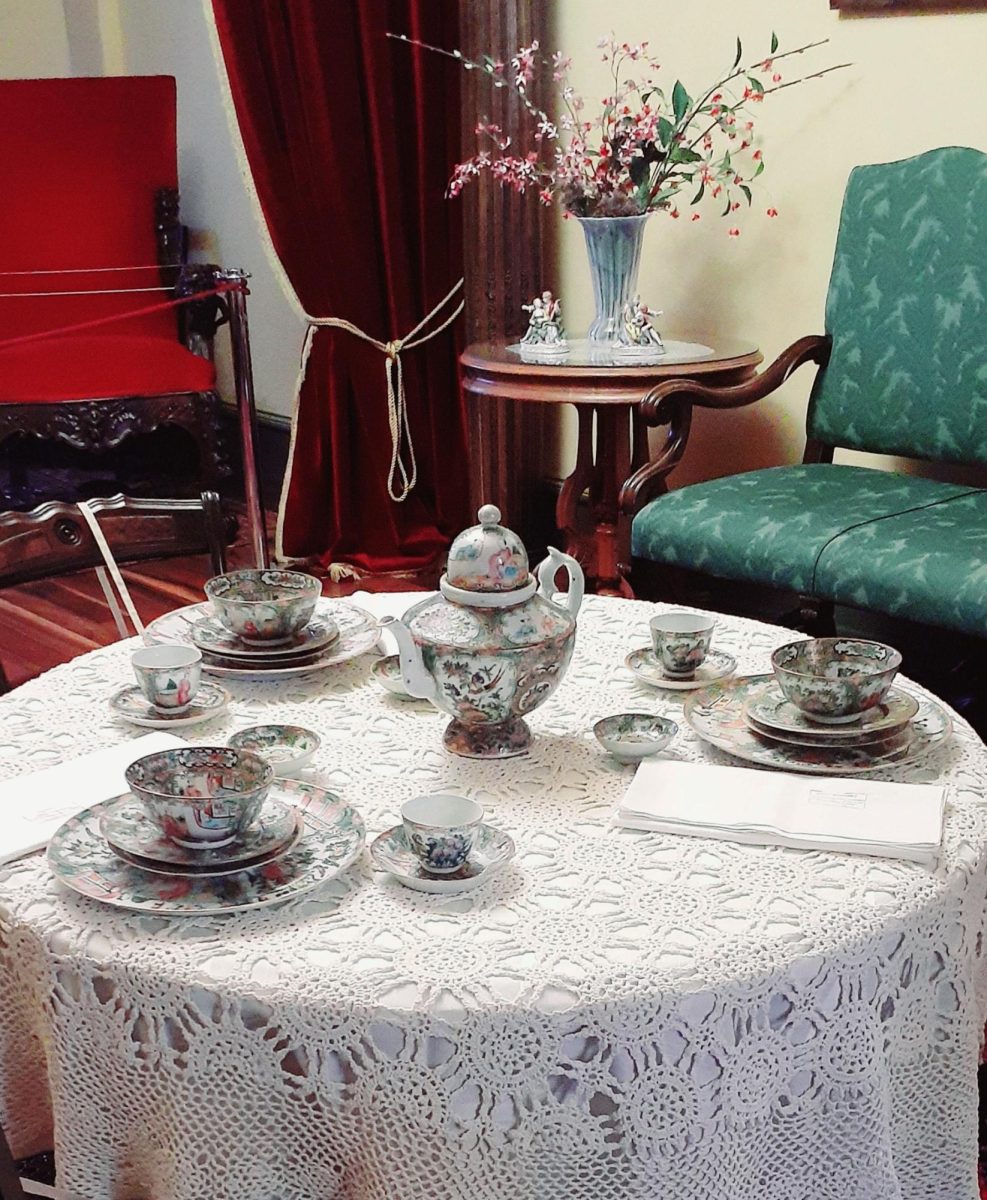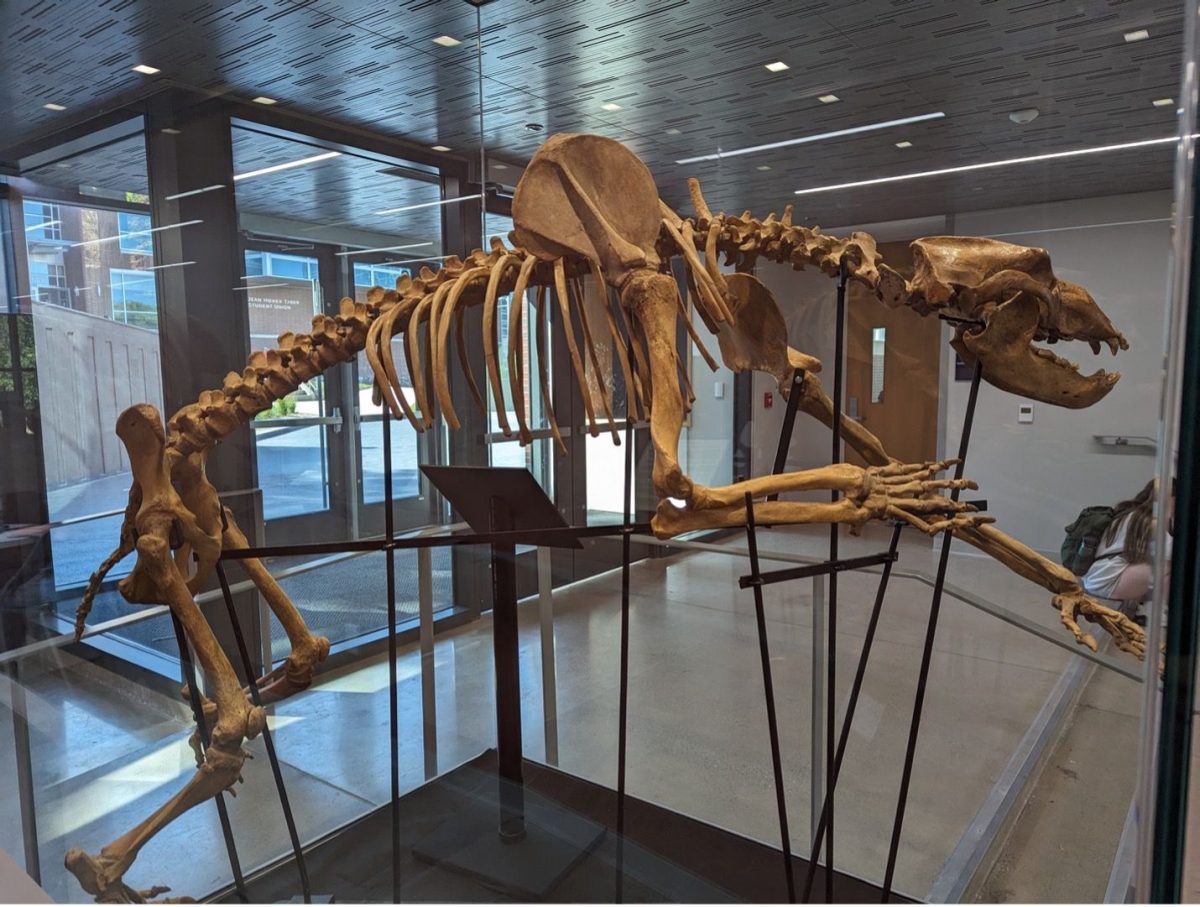This was the last statement audience members heard from Bob Huff, art director of the Myer’s School of Art as he introduced Dianna Garcia-Snyder’s Shin’m Interactive dance performance on Tuesday night.
The crowd stood in the upper atrium of Folk Hall, nervous and not knowing what to expect. She entered, dressed in a suit of black spandex with a black cylindrical hat, fin-like forms on her hands and subtle black designs drawn on her face.
“
This was the last statement audience members heard from Bob Huff, art director of the Myer’s School of Art as he introduced Dianna Garcia-Snyder’s Shin’m Interactive dance performance on Tuesday night.
The crowd stood in the upper atrium of Folk Hall, nervous and not knowing what to expect. She entered, dressed in a suit of black spandex with a black cylindrical hat, fin-like forms on her hands and subtle black designs drawn on her face.
The dance began with Dianna crouched in a metal sculpture made by student Joe Bartram. She rose from the sculpture and began to slowly move toward the audience. Faculty member Donna Webb was one of the first to interact with her, with a light nudge. She moved like water through the air, very naturally, and her movements were picked up by the pieces of her costume, which in turn made bubbly, water-like noises. She fell gracefully on a student, who was bewildered, and bent over as if being dipped.
Soon, the audience began to move her more, pushing her with slight touches and gestures and learning how she reacted to different touches. When pushed down, she bounced like a ball. A student ran a finger up her spine and she shivered happily. Some audience members tried to twirl or dip her as they would a regular dance partner. Others simply pushed her from one end of the crowd to another, like playing catch with a human form.
She fell very suddenly on the ground and rolled all the way down the walkway between the upper and lower atria, then lay collapsed on the floor. The crowd nervously chased after her. Students and faculty worked together to bring her back up and into the dance.
It was fortunate that Bartram’s installation pieces were on display, as she used his large installation pieces to dance around and interact with. It seemed that everything around her, whether it was people, art or walls, elicited some sort of organic response from her that she incorporated into the dance.
The real magic happened when she entered the Emily Davis gallery. The crowd huddled into the space and everybody was on tiptoes trying to see Dianna over the shoulders of those in front of them.
She moved to the last piece in the gallery, the interactive Formica, by Philomène Longpré’s. This piece works with visitors of its space with emotional, sensory and physical responses. Dianna seemed to communicate with the piece like a frightened animal, as if trying to fight the sounds. Her facial expressions were phenomenal; they showed surprise, astonishment, fear and pleasure with each different person or piece of artwork that she danced with. It was apparent at this point in the dance that she was no longer interacting with the crowd so heavily; she now had the interactive New Media art to respond to and inspire her dance.
In the upper gallery, she smiled as she danced with the piece Artificial Nature. This piece involved human interaction as well, and as it picked up Dianna’s movements and projected imagery on the walls; she bounced off the walls in delight.
She then moved to the first piece in the show, Eunsu Kang’s Shin’m. This piece has a jacket that hangs from the ceiling, and when the viewer puts on the jacket, a camera on the ceiling reads the lights on the hands and responds with light and sounds on the walls and floor.
Dianna at first responded to the piece with a shy curiosity, touching the suit and trying to understand it, like a small child would. She shrieked and gasped as she discovered the lights projected on the floor, seemingly trying to pop the bubbles projected into the space.
She eventually worked her way into the suit, and very naturally inhabited the space, as if it were built specifically for the creature that she became in the dance. She smiled widely, flew out of the suit and began to tug at it, screaming and trying to pull it off of the ceiling where it was attached. As if the crescendo of the performance, the suit snapped back violently and Dianna sprang back against the wall, curled up in fear, and ran into the backroom of the gallery. The audience was left in awe of the performance.
Garcia-Snyder is a dancer and choreographer and specializes in dance inspired by the Japanese Butoh style. She works at the University of Washington, where she met Eunsu and they began their collaborative work. They work together regularly to combine new media with dance, which Garcia-Snyder likes because it puts technology and humanities together to develop a hybrid.
The Shin’m project hybridizes interactive installation and performance. This hybrid offers constant and proactive transformation of objective and subjective experiences as well as both chances of in-depth appreciation and unique interpretation. Eunsu says that the interactive new media transforms the viewer into a sort of cyborg. The cyborg treads in the realms of both the cyber and real worlds. It can breathe through any kind of medium and is in actuality a medium itself.
If the visitors to the Collider 3 exhibition did not understand new media when they first walked through the gallery, the dance explained it all. Audience members learned to interact with the dancer, whose shy excitement seemed to mimic the energy of the pieces in the gallery. They also watched Garcia-Snyder interact with the art and experiment with the different responses her dance elicited. The dance brought the audience and the new media art together in a beautiful, organic understanding that only art can express.
“











